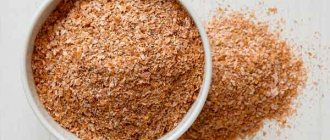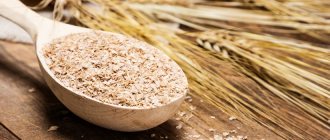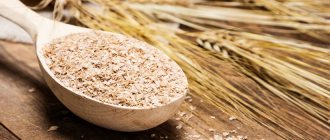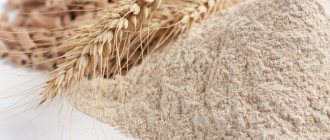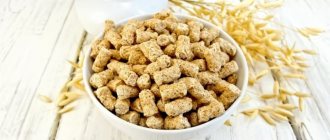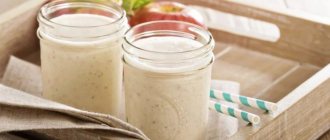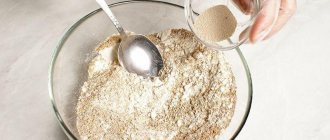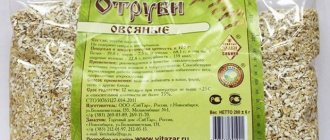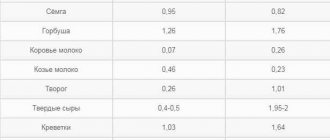Bran is a grain processing product consisting of the outer shells of grain crops. Bran contains fiber, an indigestible or insoluble fiber that reaches the large intestine unchanged. It is this property that has made the use of bran popular for constipation.
The product is considered one of the main sources of dietary fiber. Depending on the culture from which the fibers are obtained, the following types are distinguished:
- buckwheat;
- oatmeal;
- rice;
- barley;
- rye;
- wheat
A production by-product can remain after the grains are cleaned and after the flour is produced. Bran can be sold unchanged or as part of dietary supplements. The product is used for baking bread - its quantity is determined by the type of flour.
You've probably heard that nutritionists recommend eating wholemeal bread: it is made from low-refined flour. If there are no impurities in premium flour, then grade 1-2 requires the presence of a certain amount of coarse particles.
Your doctor may recommend using bran in its pure form or as part of biological food additives. They help cope with functional constipation and can be prescribed to people who consume insufficient amounts of dietary fiber in foods due to health conditions, taste preferences or eating conditions. For example, if eating large amounts of vegetables and fruits containing insoluble fiber is impossible due to food allergies or other characteristics, bran can partly compensate for this.
Bran contains both fiber and substances beneficial to the body. Insoluble fibers can be components of medications and dietary supplements used to normalize intestinal function. But bran and laxatives of this type are not interchangeable. Let us dwell in more detail on the composition and properties of bran.
Composition and properties
Bran is a waste product from the processing of cereal crops. According to researcher V. A. Grigorieva, “they contain 25–30% fiber, consisting of cellulose, hemicellulose and lignin polymer” (V. A. Grigorieva, 2003, p. 12).
Insoluble fiber is delivered to the colon unchanged, undigested. They are able to retain water, which increases the volume of stool, makes it homogeneous, and stimulates normal stool. It is believed that this is the most physiological and natural way to combat chronic constipation.
The effect of bran on the intestines can be compared to a brush: they are highly hydrophilic, absorb water, toxins, mechanically stimulate the intestinal walls and improve peristalsis. Bran is fermented by colon bacteria, so it can improve microflora and correct vitamin deficiencies.
Regular consumption of dietary fiber not only prevents constipation, but also improves the structure of the intestinal mucosa, maintains the health of the digestive system, and prevents inflammatory and other diseases.
The main beneficial characteristics of insoluble fibers in bran include:
- the ability to act as a beneficial nutrient medium for normal intestinal bacteria;
- lowering cholesterol levels and preventing atherosclerosis, heart and vascular diseases;
- blood sugar control;
- participation in detoxification processes, removal of harmful substances;
- improving intestinal motility and effectively combating constipation.
Therefore, the use of bran can indirectly affect the prevention of other diseases. The use of bran for constipation in adults helps prevent diseases such as hemorrhoids, anal fissures and other complications of chronic stool retention.
100 grams of raw oat bran contains about 15 grams of insoluble fiber, which is more than half the daily requirement. According to researcher A.I. Parfenov, “to ensure normal intestinal function, 20–35 g of fiber are needed daily” (A.I. Parfenov, 2011, p. 1746). This corresponds to approximately one kilogram of fresh fruits and vegetables.
It is important to understand that consuming this amount of food can be difficult, especially if we are talking about the average person who spends 8 hours at work. In this case, bran can become a real salvation for those who cannot adjust their diet.
It is important to remember that bran also contains insoluble fiber, which is no less useful for intestinal function. True, there are significantly fewer of them than insoluble ones. In addition, depending on the type of bran, they may include other beneficial substances:
- calcium and potassium;
- magnesium and iron;
- vitamins A, E, K, group B;
- amino acids histidine, arginine, etc.
Bran can become not only a tool in the fight against constipation, but also a source of a certain amount of nutrients. Maintaining health with bran can be recommended by a dietitian or therapist.
Products containing coarse fibers
Raspberries are a berry containing a large amount of fiber.
To replenish the daily fiber requirement (35g), you can eat foods that are rich in polysaccharides, and you can also purchase the finished product in dry form and consume it regularly according to the instructions.
Let's look at popular foods that are rich in fiber and can always be found in our refrigerator:
- Apples. It is recommended to eat firmer fruits without removing the peel. One average fruit contains no more than 5 grams. polysaccharides, so you need to eat at least 1-2 apples a day along with other foods.
- Raspberries. Of all the berries, raspberries lead in the amount of fiber. For 100 gr. product contains 8.5 g. polysaccharides.
- Avocado. The fiber content in one small berry is at least 12 grams.
- Peas. To saturate the intestines with coarse fibers, it is recommended to eat boiled dry peas. When dried, the legume plant loses all moisture, leaving only a film rich in carbohydrates. For 100–150 gr. product contains 9 grams. fiber.
- Bran bread. Perhaps this is a direct source of fiber that can saturate the body for the whole day. Several pieces of this bread contain almost 10 grams. fibers
- Legumes (beans, lentils, limes, chickpeas). Contents per small cup of finished product is 14 grams. coarse fibers.
- Cabbage. This is an economical and affordable option for obtaining fiber. In total, 1 serving of shredded cabbage contains 3 grams. fiber.
- Bran. Wheat bran contains the most fiber of any existing product. In 100 gr. contains almost 45 grams. It is for this reason that bran bread is recommended by nutritionists.
Operating principle
Parfenov believes that dietary fiber “is necessary for intestinal bacteria. As a result of microbial metabolism, short-chain fatty acids (SCFA) are formed, which retain water in the intestinal lumen and participate in the proliferation and differentiation of epithelial cells” (Parfenov A.I., 2011, p. 1746). The main mechanism of action of bran is that the insoluble fiber leads to water retention in the intestines. How does it work against constipation?
One of the mechanisms for the development of constipation is the loss of water from feces, as a result of which they become denser, compressed, and more difficult to pass through the intestines. Water retention in the intestinal lumen is one of the mechanisms by which some laxatives work. However, many of these drugs have quite a powerful effect, and the effect of their use is called drastic - diarrhea occurs, profuse and frequent watery stools appear.
Dietary fiber acts more gently: water retained in the intestinal lumen allows you to increase the volume of feces and make their consistency softer. In addition, the fibers mechanically stimulate muscle contraction, improving peristalsis. As a result, soft feces move faster through the intestines, and natural emptying occurs without mechanical obstacles in the form of dense feces.
Bran will help with constipation of a physiological nature, when stool retention is associated with eating habits, insufficient stimulation of motor skills, violation of the drinking regime, and a sedentary lifestyle.
Doctor Samsonov A.A. in his work indicates that “constipation develops in cases where fecal formation decreases to less than 100 g per day” (Samsonov A.A., 2012, p. 202). This may be due to the consumption of refined foods in small quantities. Bran increases the volume of feces by 50% when consumed in quantities of more than 22 grams per day.
In addition, dietary fiber literally absorbs toxins and removes them naturally, which helps fight intoxication caused by chronic constipation.
What is flax bran?
This is essentially waste after processing flax grains. They include the outer shell and a small part of the grain that remains after the main part of the cereal is processed to produce flaxseed oil. Surprisingly, it is these wastes that contain the maximum benefit - they contain up to 90% of the valuable substances of the seeds. Compared to rye, oat, and wheat counterparts, this type is less common, but is considered more valuable.
Types of bran
Oatmeal
Before deciding which bran is best to use for constipation, it is important to take into account the individual characteristics of the body. Oatmeal has a neutral taste, so they are highly valued for their ability to be added to ready-made dishes and dairy products. It is better to choose loose bran rather than compressed bran - manufacturers may add a certain amount of flour to the latter.
Oat bran contains a large amount of vitamins and minerals: all B vitamins, as well as vitamins A, ascorbic acid, rutin, vitamins E, D and K. They contain lycopene, an organic compound with an antioxidant effect. This composition will help maintain the health and beauty of your skin and hair. Oat bran also contains minerals: iodine, iron, potassium, phosphorus, magnesium, calcium. This will also have a beneficial effect on the health of the musculoskeletal system, nervous system and other systems and organs.
Wheat
Researchers Parfenov, Ruchkina and Silvestrova in their scientific work indicate that “wheat bran is widely used for prevention and treatment” (Parfenov A.I., Ruchkina I.N., Silvestrova S.Yu., 2006, p. 109) .
Indeed, this is the most common recommendation in gastroenterological practice. This product contains not only insoluble fiber, but also calcium, potassium, magnesium, zinc, and manganese. Bran contains vitamin E, riboflavin and other B vitamins, as well as choline. This organic compound was previously called vitamin B4. The substance affects carbohydrate metabolism, has hepatoprotective properties, and is involved in the prevention of liver and kidney diseases.
Wheat bran also contains amino acids:
- Histidine, which promotes tissue growth and repair and is part of hemoglobin.
- Arginine, which is especially needed by children, adolescents and the elderly, is involved in anti-inflammatory processes and stimulates the normal functioning of blood vessels.
Rye
Rye bran is especially valued by those who want to lose weight. This is one of the lowest calorie types of product - only 220 kcal per 100 g. Rye bran for constipation can be recommended by both a gastroenterologist and a nutritionist. This bran contains a lot of potassium and calcium, magnesium, phosphorus, sodium, potassium, as well as trace elements - iodine, cobalt, manganese, copper, etc.
This type of bran contains the same vitamins as wheat and oat bran, but their composition differs in the presence of omega-3 and omega-6 polyunsaturated fatty acids. The latter are especially important in the prevention of many diseases, they can improve the functioning of the nervous system, participate in the prevention of many diseases and strengthen the body's defense mechanisms.
Rye bran also contains beta-glucan, a compound that binds fatty acids and reduces the level of so-called bad cholesterol. Therefore, in addition to the main action - treatment and prevention of constipation - the product has a lot of health-improving effects. Thus, it helps protect the heart and blood vessels, improves the functioning of the nervous system and digestive organs.
Get rid of intestinal problems
The natural British drug is not addictive and works immediately
Find Phytomucil with benefits
Which bran is better for weight loss - wheat, rye or oat bran?
- All types of bran are beneficial, and each has its own characteristics. They are rich in minerals and vitamins, which has a positive effect on the body:
- oatmeal - clean and strengthen blood vessels, normalize blood pressure, improve the functioning of the liver and kidneys, pancreas, and have a positive effect on appearance;
- wheat - fight dysbiosis and constipation, normalize glucose levels, reduce the acidity of gastric juice;
- rye - have a positive effect on the reproductive system, the functioning of the adrenal glands, eliminate anemia, vitamin deficiency, and normalize the water-salt balance.
Nutritionists recommend consuming all types of bran. They are a by-product of cereal crops, and their benefits and value have long been known.
Did you know? If you keep a bottle of mint, banana or apple scent next to you, you can trick your brain. The smell is perceived by cells responsible for the perception of satiety as a signal of satiety.
Thus, bran is a valuable source of vitamins, minerals, amino acids and fiber. Proper use of the product will help reduce and control weight.
Indications and benefits
The benefits of bran for constipation can be very great, but this is not the only indication for their regular use. A doctor may recommend such a nutritional supplement for diabetes, obesity, certain skin diseases, weakened immunity, and high risks of developing atherosclerosis. The basis for the recommendation is considered to be high levels of cholesterol or glucose in the blood, some diseases of the liver and biliary tract.
Bran is indicated not only to eliminate existing intestinal problems, but also to prevent their development. For example, with a forced restriction of the diet, a new diet, the risks of developing constipation increase, and with the help of bran, the development of stool retention can be prevented.
The benefits of bran may include the following beneficial effects:
- normalization of blood sugar and cholesterol levels;
- detoxification of the body;
- prevention of diabetes and atherosclerosis;
- normalization of the functioning of the digestive system;
- stimulation of muscle growth and recovery;
- strengthening bone tissue;
- prevention of anemia;
- improvement of metabolic processes in the cells and tissues of the body.
Insoluble fiber is a substrate for beneficial bacteria in the gastrointestinal tract. Therefore, they can be used in the treatment and prevention of dysbiosis by improving the composition of the intestinal microflora. In addition, they stimulate the normal flow of bile.
Bran promotes long-term satiety and can reduce appetite, which means it can be used as part of comprehensive programs for weight loss and obesity prevention. The doctor may prescribe them if there is a forced limitation on the amount of food eaten, as well as if the patient consumes mainly unrefined foods that do not contain dietary fiber.
The use of bran is also relevant for people with allergic reactions that limit the possibility of including fresh vegetables, fruits and berries in the diet as the main source of dietary fiber in the diet.
Features of taking bran for constipation
It is better to ask your doctor how to take bran for constipation. Despite the fact that this is not a drug, there are a number of contraindications to their use. If you have already found out that there are no restrictions, your doctor will give recommendations on how to properly start introducing such a supplement into your diet.
The standard amount of bran for an adult is no more than 25-30 grams per day. This is about two tablespoons. Try to maintain the dosage and not exceed it to reduce the likelihood of side effects.
If you are taking medications, it is important to strictly follow the rule: wait at least three hours between taking the pill and consuming insoluble fiber. Fiber acts as a natural sorbent, so it can reduce the effectiveness of the drug if the interval is shorter.
We have prepared several general rules for using bran:
- Try to consume bran in the first half of the day. The best option is considered to be in the morning, before breakfast.
- Introduce bran carefully, start with 5 g - a heaped teaspoon. Observe the body’s reaction, and if everything is fine, gradually add a few grams to the norm.
- It is not necessary to consume 25-30 grams of bran; if your diet is expanded on some days and contains fresh vegetables and fruits, a reduction in the dosage is allowed.
The most important rule when consuming bran is to drink enough water. Moreover, if your norm is one and a half liters of fluid per day, an additional volume should be added to it.
Samsonov in his scientific work focuses on the fact that “the consumption of food bran must be accompanied by a sufficient amount of liquid (2-3 glasses to the patient’s usual water diet), on average up to 2 liters of liquid per day (in the absence of corresponding contraindications)” .
We are not talking about cases where so much liquid is contraindicated - in such situations the use of bran is also contraindicated. Since there is a high risk of disruption of intestinal transit and aggravation of existing problems with stool. Bran should never be consumed dry!
How to take bran correctly for constipation - in dry form or as part of dishes? This is purely a matter of taste. You can add them to your favorite dishes or eat them yourself. Many researchers say their benefits do not change across different methods.
Thus, Samsonov insists: “Bran should be added to first courses, porridges, salads, fermented milk products” (Samsonov A. A., 2012, p. 202). It is important to know that many manufacturers of fermented milk products produce products with already added cereals and bran - pay attention to the composition when purchasing.
The same researcher recommends first pouring boiling water over the bran, and consuming it only after 30-60 minutes as part of ready-made dishes. Moreover, the dose can vary from 1 to 8 tablespoons. When increasing the dosage, pay attention to your condition and individual reactions of the body - if flatulence and other digestive disorders occur, it is not recommended to increase the dose.
Features of choice
In order for wheat bran to bring only benefits and not harm, you need to choose them carefully. The product is sold in different forms: loose, granular. But experts recommend choosing bran in the form of regular husks, as they have the maximum number of beneficial properties.
The composition should not contain sugar, flour, cereal or any other additives. They only increase the energy value of the product and do not add any benefit to it, but, on the contrary, reduce it.
The average calorie content of wheat bran is about 180 kcal per 100 grams
Possible harm and contraindications
The use of bran may have certain consequences. For example, doctor Parfenov in his scientific work emphasizes that patients are reluctant to agree to the use of bran “due to flatulence, discomfort and increased formation of gases” (Parfenov A. I., 2011, p. 1746). Indeed, bran against constipation is effective in most cases, but can be a source of discomfort.
Researcher A. A. Samsonov speaks about this: “almost all patients who start taking dietary fiber, especially the elderly, experience temporary bloating, a feeling of rumbling, and pain due to increased gas formation during the first few weeks of their use. This effect is associated with excessive bacterial fermentation of fiber in the colon" (Samsonov A. A., 2012, p. 202). These effects are the main obstacle to the use of bran.
As for contraindications, they are quite strict: in some cases, bran can significantly worsen the condition and even cause serious complications. Limitations are represented by the following diseases and conditions:
- all diseases for which it is impossible to take a large volume of liquid per day, for example, kidney pathologies;
- organic pathology of the large intestine;
- high probability of intestinal obstruction, fecal impaction;
- old age;
- severe neurological diseases;
- bed rest;
- stool incontinence or high risk of developing incontinence (older age).
A relative contraindication is irritable bowel syndrome (IBS). According to some data, in a number of patients with IBS accompanied by constipation, bran can cause increased pain.
It is important to understand that insoluble dietary fiber causes unpleasant consequences more often than soluble fiber, and can sometimes worsen constipation. One of the best options for stool retention are bulk laxatives, which contain not only insoluble but also soluble fiber.
For example, “Fitomucil Norm” contains the shell of plantain seeds and the pulp of domestic plum fruits. Insoluble fibers gently stimulate intestinal motility, while soluble fibers absorb water and turn into a gel, providing a softening effect and helping to restore regular bowel movements. This allows you to speed up the process of excretion of feces, as well as make them softer. The product acts predictably and does not cause pain or bloating, as well as diarrhea or watery, frequent stools. In addition, Fitomucil Norm helps to normalize microflora and, as a result, restore normal functioning of the gastrointestinal tract on a long-term basis.
Contraindications for use
Taking care of yourself and your appearance is a good thing, if you don’t go to extremes. Before you decide to try a diet (not just bran), be sure to consult your doctor! Only a specialist will weigh the pros and cons. Contraindications to the bran diet:
• all types of ulcers
• gastritis
• cholecystitis
• hepatitis
Find out also what glucophage is for weight loss.
Recipes with bran
Water with honey and bran
This recipe is also suitable for people with stomach diseases. Need 4 tbsp. l. wheat or oat bran, pour 40 ml of hot water, leave to steep for 4 hours. Then stir, strain and squeeze, heat the finished infusion, add 1 tbsp. l. honey This infusion can be drunk an hour before breakfast.
Bran with beets
Beets have a laxative effect, so this combination of products can help relieve constipation. To prepare you will need 150 g of beets, 20 g of bran, 15 ml of flaxseed or other vegetable oil, salt to taste.
The bran should be poured with hot water for 30 minutes, and the remaining liquid should be drained. Peel the beets, grate them on a fine grater, mix with bran. To add flavor to the salad, you can add chopped herbs, salt, and use vegetable oil for dressing. This dish can be eaten warm or cold at any time of the day, or used as a side dish for the main dish.
Bran porridge with prunes
How to use bran correctly?
If you have not previously taken coarse fiber, then the initial dose should not exceed 1 teaspoon. This dosage must be maintained for at least a week. In the absence of negative reactions, the dose is increased to 1 tablespoon per day. It is also taken throughout the week. Let's move on to the main method - 2-3 tablespoons (30 g).
Two questions remained unanswered: when to eat bran and how many days the course lasts. Nutritionists believe that the most appropriate intake is in the morning during breakfast. It provides a long-lasting feeling of satiety, which is especially important when taking this product for weight loss. Bran sticks can be consumed as an afternoon snack for a light snack. It is allowed to divide the daily dose into 2-3 doses. The duration of the course depends on the goal that a person wants to achieve.
Purgation
To cleanse the intestines and body of waste and toxins, the course of treatment should last at least 2 weeks. Indications for such a course are:
- disruption of the bowel movement process;
- the appearance of a pustular rash on the skin;
- unhealthy complexion;
- decreased immunity and susceptibility to colds.
Since bran in its natural form is a rather coarse product, before use it is recommended to soak it in water, kefir, or ayran for 15 minutes to soften it. You can suggest this recipe:
- bran soaked in water, prunes, raisins in a ratio of 1:2:1 are mixed and crushed;
- Take 2 tablespoons 3 times a day half an hour before meals.
Bran should not be considered a superfood: it only helps you lose weight.
For weight loss
To master the secret of easy weight loss and weight maintenance, you can choose any type of bran and start taking it before or during meals. You can use them on their own or add them to vegetable salads, cottage cheese, porridge, soups; you can prepare dietary baked goods with the addition of nuts, dried fruits and a small amount of honey. The course of treatment lasts for at least 2 months. There is no need to increase the dose beyond 30 g, even if you strive to get the desired result as quickly as possible. Sweets are allowed, but in reasonable quantities. And if it is difficult for you to give up starchy or sweet foods, then this leads to the opposite effect.
The famous diet of Dr. Dukan suggests using oat bran, but it is not forbidden to take a mixture of different types of bran.
When using a diet for weight loss, the absorption of vitamins and other useful biologically active substances may be reduced due to the sorption effect of dietary fiber. You can compensate for the deficiency by including vitamin-mineral complexes in your diet in separate doses.
You can offer 3 options for diets for weight loss.
- Breakfast - oatmeal and apple. Second breakfast - cottage cheese and tea. Lunch - first with a piece of bread. Afternoon snack - fruit. Dinner - a glass of kefir with bran.
- For 2 weeks, eat 3 times 1 tbsp. spoon of bran, washed down with plenty of water. After 3 hours, you can eat vegetables and unsweetened fruits, lean meat and fish, low-fat dairy products, green tea, and still mineral water.
- To the usual diet, add 1 teaspoon of flax bran every day 3 times in the first 2 weeks, then change the spoon to a tablespoon and continue for another 2 weeks.
Fasting days are carried out once every 10 days. Nutritionists advise using finely ground flax bran. A tablespoon of ground bran is washed down with a glass of water or kefir. You can take 3 tablespoons per day. No other food is allowed on this day.
Bran is a very necessary food additive to our menu; with its help, you can cleanse the intestines and lose excess weight.
Examples of recipes with bran
Many people know about the benefits of kefir drunk before bed. Bran will help improve the effect. For a glass of low-fat kefir or natural yogurt, add 1 - 2 tablespoons of bran and a small amount of honey. In the morning you will have easy and free bowel movements. This recipe can be used instead of breakfast, which will promote weight loss. Patients who lost weight and used bran on a diet noted a long feeling of fullness and a refusal to snack on cookies, cakes and other high-calorie foods.
The bran porridge recipe is easy to prepare.
Boil a mixture of water and low-fat milk, taken half a glass each. After boiling, add 2 tablespoons of oat bran, a tablespoon of sugar and vanilla. Cook for 8 minutes over medium heat, stirring.
The diet cookie recipe will require the following products:
- 1 egg white;
- 1 tbsp water;
- 1 tbsp. spoon of vegetable oil;
- 2-3 tbsp. spoons of whole grain flour;
- 1 tbsp. spoon of wheat bran;
- a quarter teaspoon of soda. To improve the taste, add raisins and nuts.
Research confirms that fiber reduces appetite. This occurs due to its swelling in the stomach.
Knead the dough, roll out the sheet 3 mm thick, cut out the figures, bake in the oven at 220 degrees until golden brown.
This is how a vegetable smoothie is prepared. Blend 200 grams of grated carrots, 200 grams of tomatoes, 1 teaspoon of rye bran and a little ground black pepper. Can be used instead of an afternoon snack or other snack.
